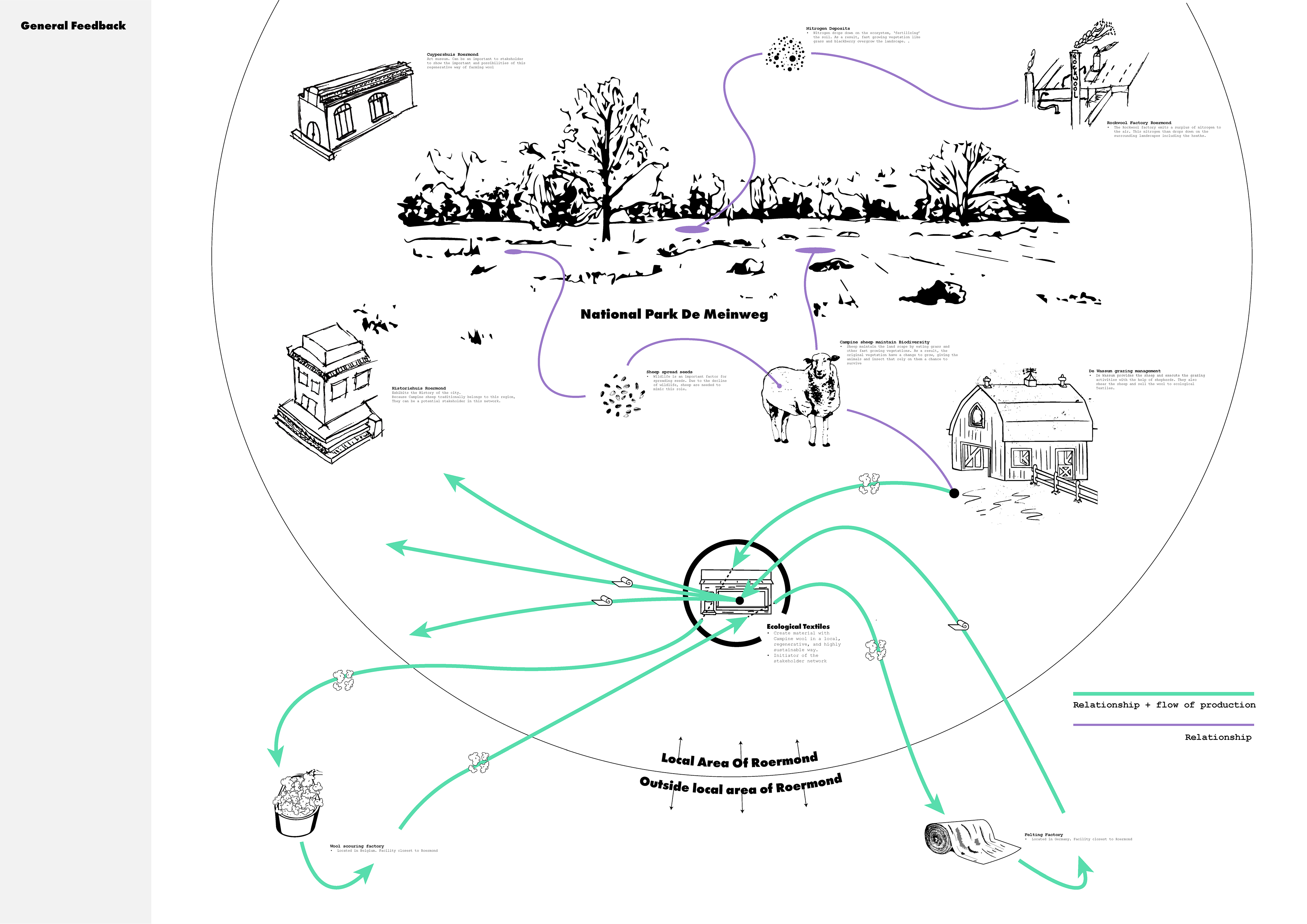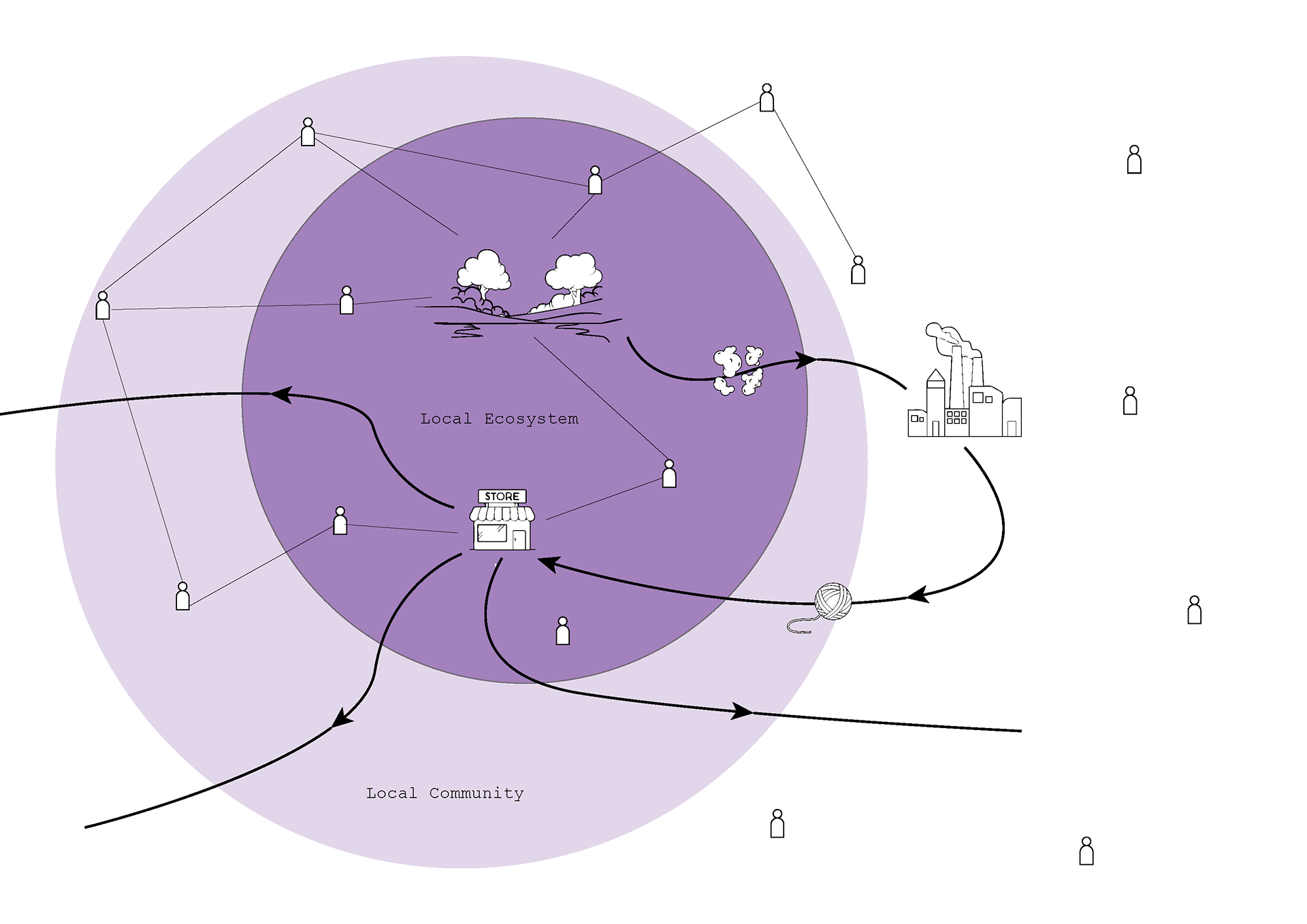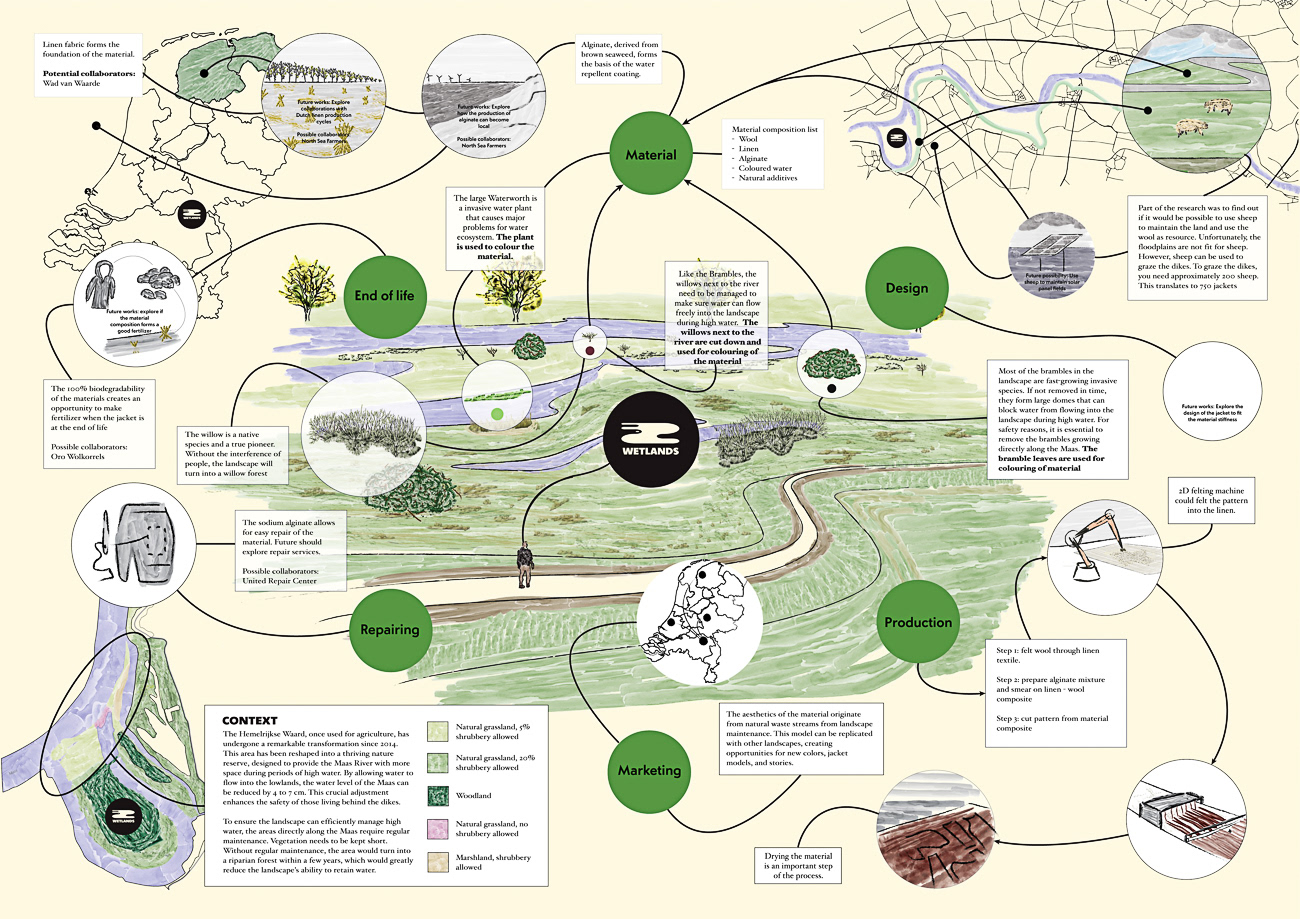Expertise Area Development
Business and Entrepreneurship
My bachelor’s formed the basis of my theoretical knowledge of corporate structures, business models, value propositions, and marketing strategies. Despite having learned multiple strategic business tools, models, and frameworks, I noticed a lack of resources to approach business in a post-anthropocentric way. This substantially clashed with my vision. Consequently, I aimed to find new frameworks and approaches to create business opportunities from a post-anthropocentric perspective. In the end, I found solace in regenerative business practices and aimed to explore if and how I could establish regenerative production systems within the wool market. As such, the past 1,5 years have been dedicated to acquiring more knowledge on how to interpret, define, and build regenerative business systems. In the end, I applied this knowledge by defining a regenerative company for my FMP. To do this, I explored business opportunities in the context of the wool market throughout my master's projects.
During my M1.2 project, I learned that 75% precent of the wool is thrown away in the Netherlands. As a result, I noticed an opportunity to develop a composite material with wool. Parallel to this activity, I did a literature study on how to position a company in the transformation economy paradigm. This gave me insights into how value can be extracted from local stakeholder networks. Moreover, through interviews with multiple experts in the textile industry, I learned that another big problem within the European wool market is the washing process. As a result, I dedicated the M2.1 project on creating an innovative solution for washing wool with less water, less energy, and on a local scale. From a Business perspective, I imagined how this production process could be realized within a specific place and in a regenerative way. Furthermore, through market research, I identified an opportunity to innovate the rainwear market by introducing 100% natural and biodegradable outdoor jackets in my FMP proposal. Finally, to bring everything that I learned on regenerative business together, I conceptualized the regenerative brand Wetlands during my FMP and provided important business elements. These elements were substantiated by a detailed price calculation, marketing positioning, production process, and potential B2B collaborations. During all these projects, I put an emphasis on building and expanding my professional network by researching out too many experts, companies, and organisations in the wool and textile industry.
Apart from the individual projects, I also acquired additional skills throughout my master’s that fortify my expertise on Business and entrepreneurship. During the M1.1 project,
Furthermore, the course Design Entrepreneurship taught me the importance of collaboration with other people/organizations/companies to achieve a goal and make a business work. Moreover, I learned how to share and protect my ideas when collaborating with others. Additionally, I learned how to quantify success criteria and measure the impact of value propositions. On top of these learnings, I learned about the transformation economy during the course Design for Social Innovation.
In summary, I can confidently say that I have a good understanding of basic business principles concerning entrepreneurship, intellectual property rights, and business ethics. Expanding on this, I have truly deepened my understanding of how to establish production systems to create added value through local stakeholder networks in a regenerative way. As a result, I believe I am equipped with the right tools and knowledge to bring my design project to real-life applications by identifying and creating regenerative business opportunities.
Creativity and Aesthetics
Defining business opportunities has been the main driver for my master’s. Rather than simply identifying a business opportunity within an existing market, I challenged myself to uncover opportunities at the cutting edge of innovation. Simultaneously, I wanted to do this in a highly sustainable way. This meant breaking free from the world as we know it. Consequently, I put a lot of emphasis on reshaping my design process to facilitate the creation of novel material compositions and innovative business opportunities. unexpected outcomes on a material, product, and ultimately business level. on developing new tools to uncover opportunities and reshape
Coming from the bachelor’s, my design process would trypically start by reading into a topic of preference, defining a design challenge, brainstorming, ideating, and sketching concepts, before moving into the making process. However, having completed my Master’s, I now take an very hands-on approach and engage with the making process right away. This hands-on approach allowed me to generate and refine ideas quickly.
I have always enjoyed making digital illustrations to display my design ideas. During my bachelors, this often came in the form of 3D models and detailed product pictures to capture the functionalities of a concept. Expanding on this, I learned, during my master’s, to apply these skills to visualize and make sense of the highly complex systems of relationships, interactions, and values. I did this by making infographics. These systems encompassed humans, non-humans, communities, landscapes, ecosystems, organizations, cultural values, history, and societal issues within specific contexts.
Visualizing these intricate systems enabled me to distil key elements within this system and restructure practices, behaviours, values, and ways of living to uncover design and business opportunities. Moreover, this also allowed me to imagine how the system could potentially change when design or business activities are done.

Makerspace Entangled Inforgraphic

Local value network for Campine Wool in Roermond

Entangled relationship map inforgraphic CWS Squad space

Local value network for Campine Wool in Roermond

Regenerative value network Wetlands

Rergenrative and local cleaning process wool
User and Society
As stated in my vision, I strongly believe that, to realize a truly sustainable future, human society is ought to decentralize it-self and relearn how to co-operate, co-create, and co-evolve with natural systems. This is no easy task that requires innovative methodologies, approaches, and perspectives to do this in an ethically and morally right way. I believe the role for designers is indispensable in this transition as we can provide the tools to empathise with non-human and involve them as main stakeholder in the design process. While understanding the emotional and physiological needs of human users does play a role in some of my projects, the emphasis lied on considering the needs of non-human entities such as animals, plants, ecosystems, and landscapes. This process is inherently messy and requires a brought set of creative skills to do this in an ethical and moral way. As a result, I put much effort on developing a variety of methods and approaches to allows the participation of non-humans in the design process.
During my M1.2 project, I performed a landscape ethnography study in combination with auto-ethnographic reflections. This helped me to immerse myself in the ecosystem on the dikes along the maas and notice the presence of individual non-humans. By describing my experiences in the form of poetry, I was able to capture the perceptions and emotions from the perspectives of these non-humans. This ultimately initiated reflection on how I could perform design interventions in the landscape without disturbing the existing relationship between non-human entities.
During the M2.1 project, I explored how to establish a caring relationship with microorganisms through bio-digital artefacts such as a bioreactor. Growing and caring for the micro-organisms with the bioreactor over longer periods of time resulted in a more engaging attitude and empathy towards the bacteria. Expanding on the caring element, I consulted expert perspectives to co-imagine a regenerative production system for cleaning wool. This was done through a care lens; taking care of individual non-humans withing the landscape of the Hemelrijkse Waard by means of the production process of cleaning wool.
During my FMP, I further expanded my skillset by taking on the perspective of non-humans and understanding their needs and position within the landscape by imitating their behaviour. In terms of involving human stakeholders and understanding their behaviour, experiences, and sociology, I performed a user-test during my FMP project to understand how I could create value on a product level by finding a fitting application for the material. In the end, I manged to combine the needs of a multi-stakeholder network into a valuable product and business system.
Compared to where I was before starting this master’s program, I believe I have significantly deepened my understanding of how to navigate and address the complex interplay between human and non-human needs and desires in designing new materials, products, and production systems. Moreover, by following the courses Design for Behaviour Change and Interactional Morality, I fortified my knowledge with theoretical understanding and learned to interact with humans and non-humans in an ethical and morally right way.
Technology and Realization
Although not my primary expertise area, Technology and realization has played an eminent role in my projects. During my Bachelor’s, I emphasized physicalizing my projects and aimed to build tangible proof-of-concepts that could bring the concept to life. However, during my bachelor's, this, most of the time, did not involve electronics and I would most of the time rely on wizard-of-oz strategies. As a result, I aimed to advance my technological understanding during my master’s and explore how to make a place for technologies in my design process. In the end, I can say that I significantly improved my skills in building prototypes and artefacts that include technological facets. More importantly, I fortified my knowledge on electronic components and better understand the capabilities and limitations of a variety of hardware and software-related elements. Consequently, I am now capable of not only realizing the technological elements of a prototype but also able to ideate concepts from a technological perspective. In terms, this allows me to quickly understand opportunities and limitations without the need for trial and error. Having successfully completed my 2.1 project, I can confidently say that I have a good understanding of a wide variety of electrical components, know how to read datasheets, understand how to build advanced electrical circuits safely, and can resolve issues using a step-by-step protocol.
Furthermore, I have deepened my understanding of chemical engineering concepts, and I am able to comprehend material characteristics at the molecular level. My M1.2 explored historical knowledge on milk protein polymerization and investigated if biocomposites made from agar agar and cornstarch can be given hydrophobic properties. Similarly, this understanding allowed me to imagine how microorganisms could potentially clean wool in my M2.1 project. In line with the advancements in my chemical and technical understanding, I have also developed a solid grasp of fundamental biological and ecological concepts, allowing me to communicate effectively with experts from these fields of research. This understanding, along with my understanding of chemistry, enabled me to configure a composite material that is water resistant, made of all-natural materials that are locally grown and maintains a landscape during the FMP project.
Finally, the FMP project also allowed me to develop my pattern-making a clothing-making skills. Although my vision is situated within the context of the clothing industry, I have, strangely enough, never done anything related to making clothes. Consequently, I developed my sewing and pattern-making skills during my FMP project. The result is a fully biodegradable outdoor jacket. I believe these skills allow me to better communicate with experts in the field and improve my understanding of the capabilities when designing wearables.
M2.1: 3D moddelig the Bioreactor | Creating a laser print file | Assambling the Bioreactor
M2.1: Building electrical circuits including a wide variety of components | Adding the sensors to the bioreactor beaker
FMP: Engaging in patternmaking and sewing my first garment. This garment eventually became the final product of my FMP
Math, Data, and computing
I used to think that the expertise area of Math, Data, and Computing was not in line with my interests and that building advanced programs to better understand the intricacies of quantitative data did not fit my design process. My interests lie in creating new materials and exploring innovative methods and techniques to allow more-than-human participation in this process. As such, I felt that, apart from engaging with machines to craft these materials, there was no need or room for data representations, simulations, or models. However, throughout my master's, I have learned to apply these competencies and found a way to integrate Math, Data and Computing in my design process.
The process of noticing, understanding, and ultimately, engaging with non-human entities and exploring the intricate and complex relationships these non-humans have with their environment is an inherently messy and highly exploratory process. Throughout my master's, I experienced first-hand the important and sometimes indispensable role Math, Data, and Computing can play in unravelling and comprehending these messy relationships. For example, during the Quetta project, my team and I built an artefact that could sense the internet strength in the Atlas building and converted the data into comprehensible metrics. My role in designing this probe was exploring how to measure the internet strength and building the associated code and electrical circuit to translate the data into sound, vibration, and light. Furthermore, During my M2.1 project, I explored if I could establish a caring relationship with the micro-organisms. The invisibility of micro-organisms with the naked eye, however, made this no easy job to do. In the end, I managed to work around this difficulty by building a DIY bioreactor with a variety of sensors that could sense the living environment of the micro-organisms. Interestingly, by plotting the data and making measurements over longer periods of time, I found a way to measure the activity of the micro-organisms. Ultimately, measuring the activity of the micro-organisms turned out to be a crucial element in building a caring relationship with the micro-organisms. The Quetta project and M2.1 project taught me how to deal with large sets of quantitative data, reduce sensor noise, plot data to find emerging patterns and transform variables into understandable metrics.
While Math, Data, and Computing is not my strongest, I feel much more confident designing data-enabled elements in my design project. Consequently, I would consult data-driven insights much earlier in future projects.
M2.1: Resolving interference and reducing noise on the pH sensor | Growing the bacteria and plotting data of the PH sensor over longer periods.
M2.1: measuring temperature, pH, and turbidity of growth medium
M2.1: pH dropping back to 7